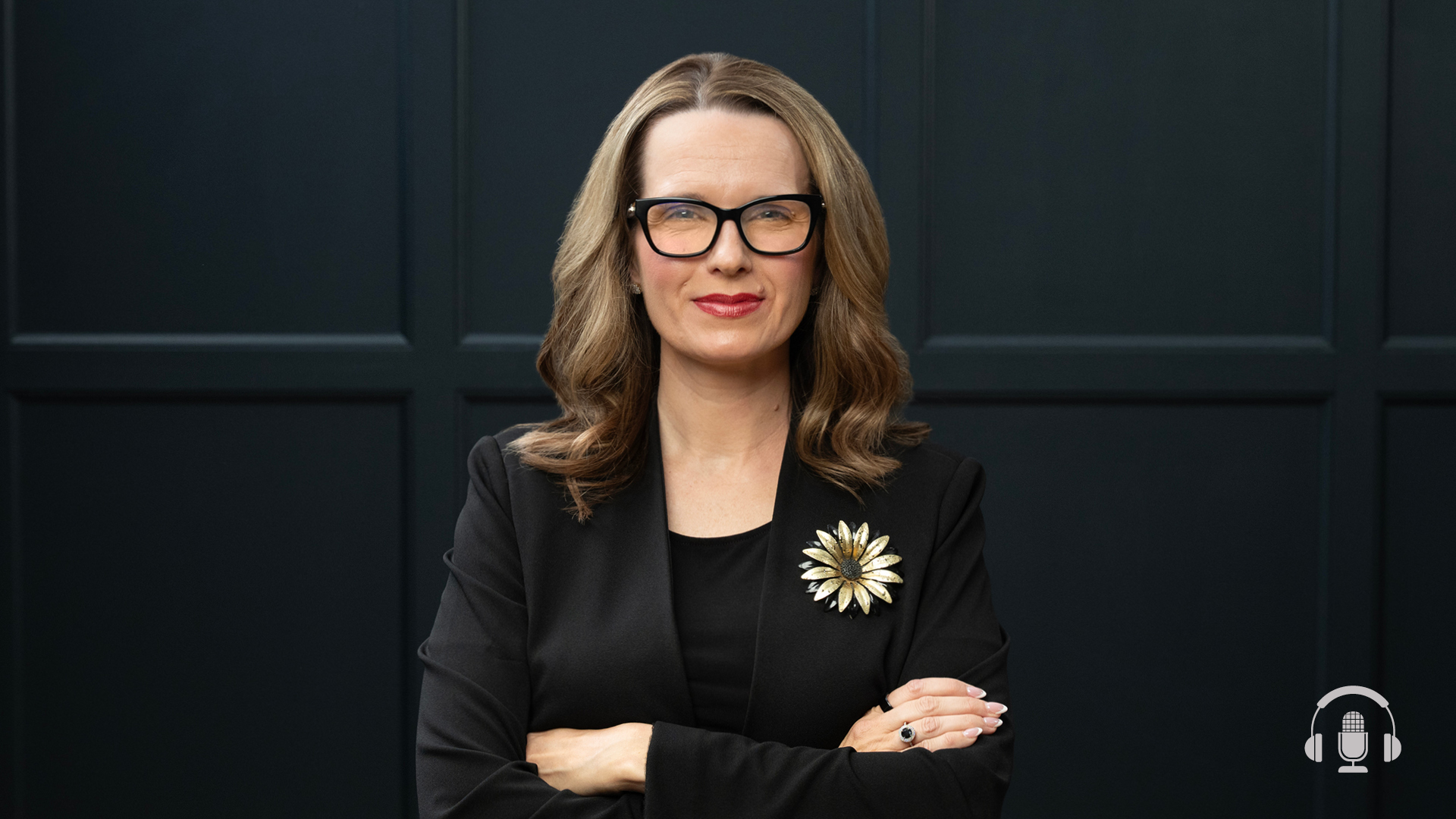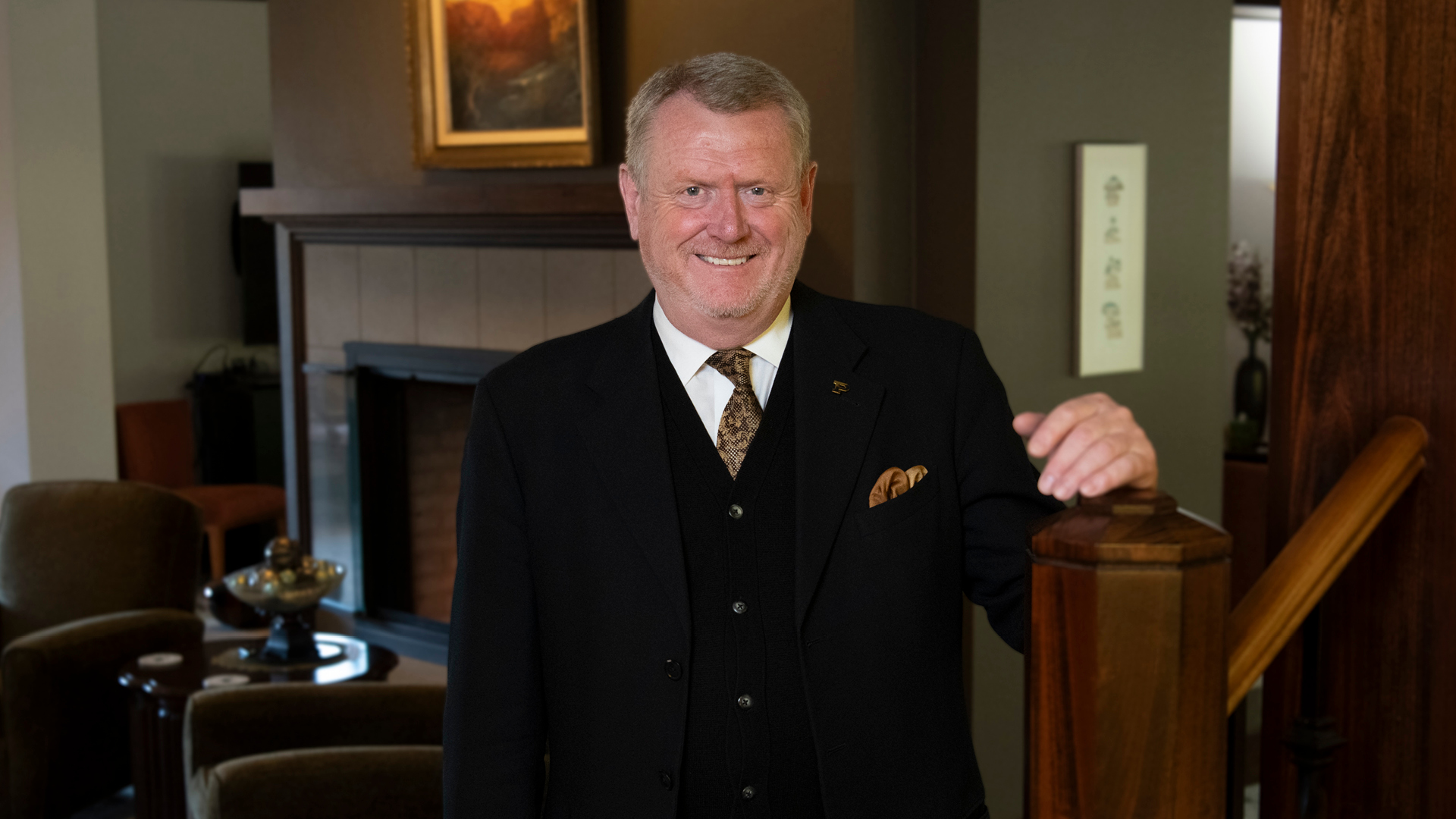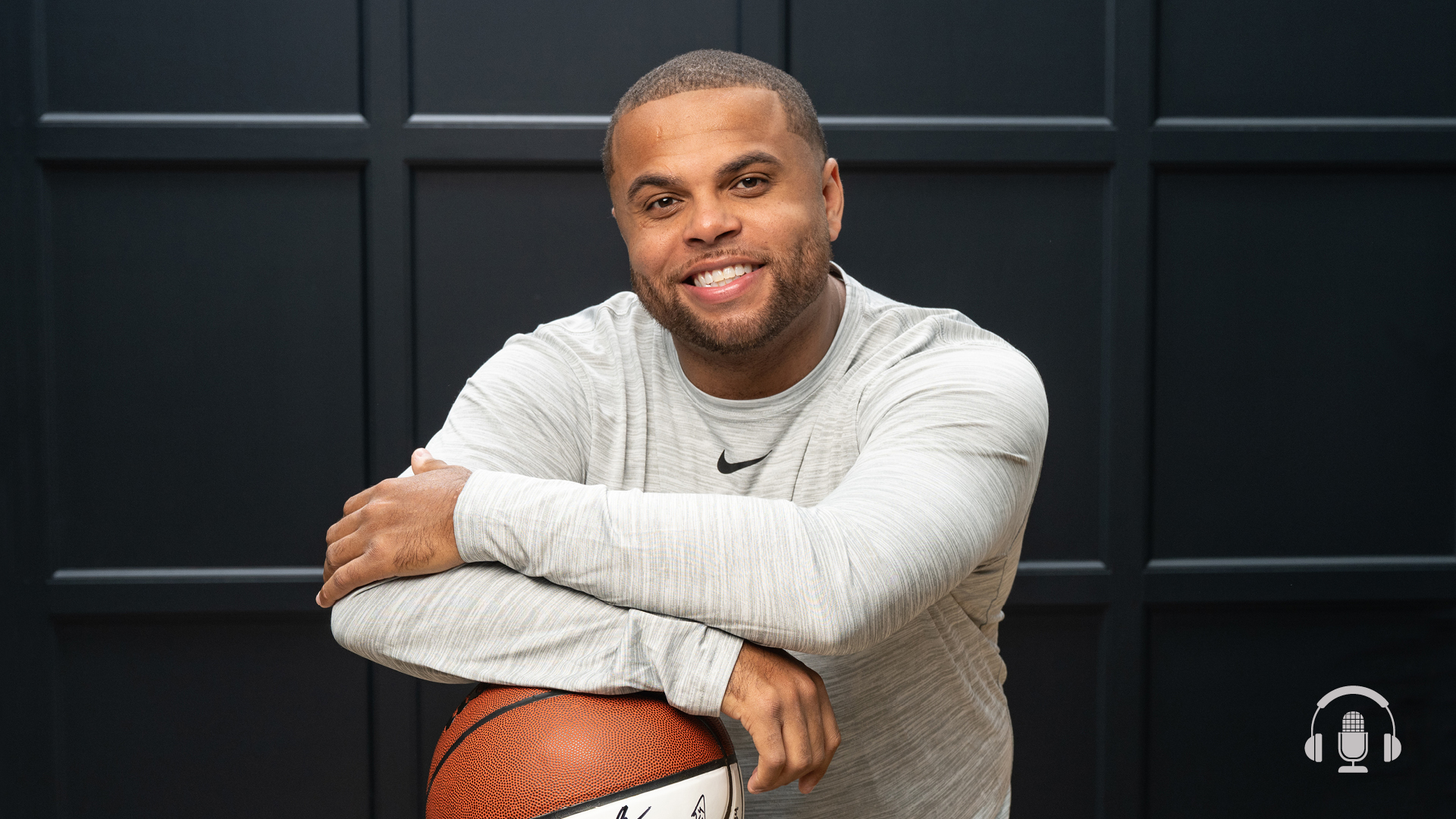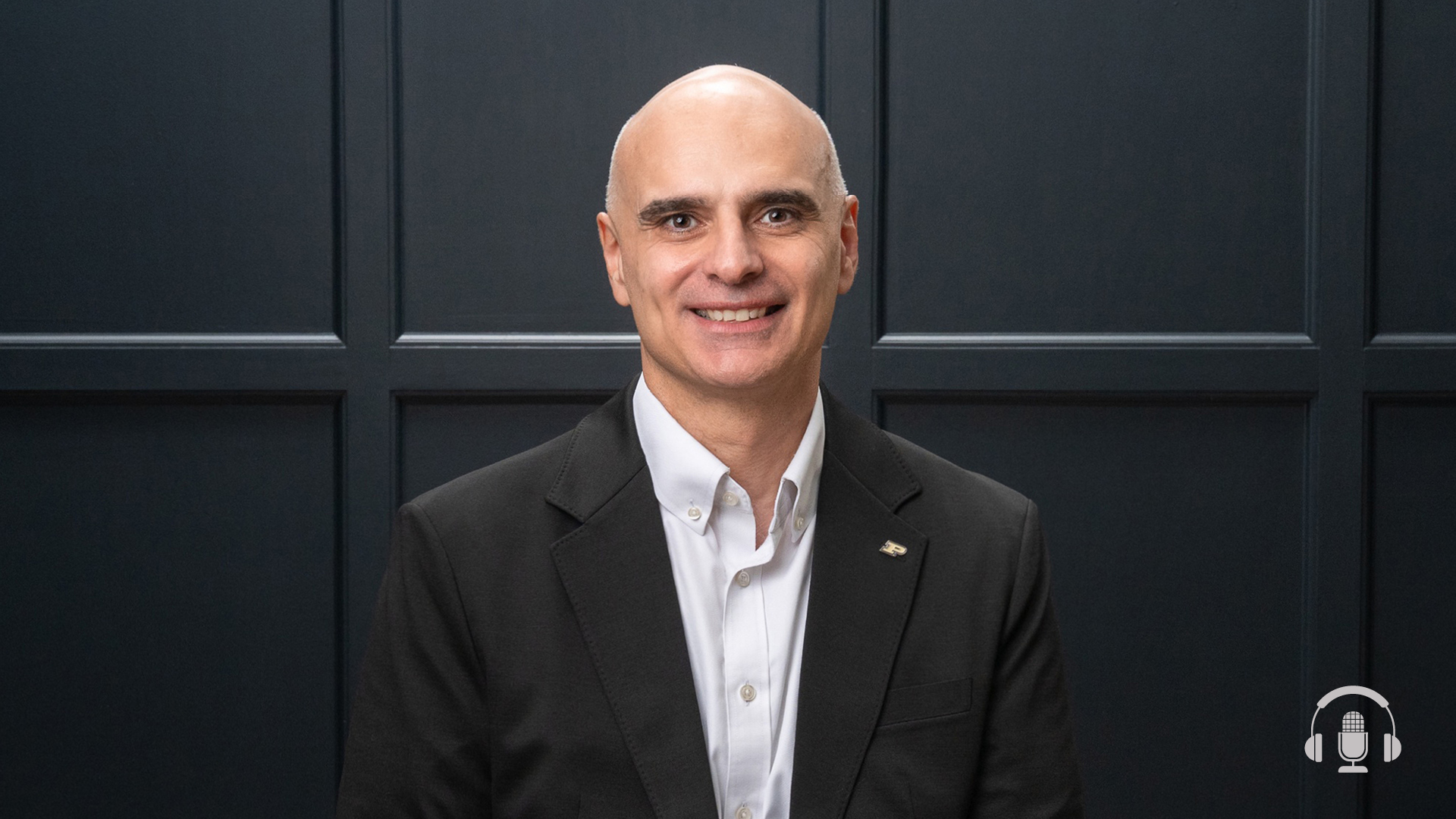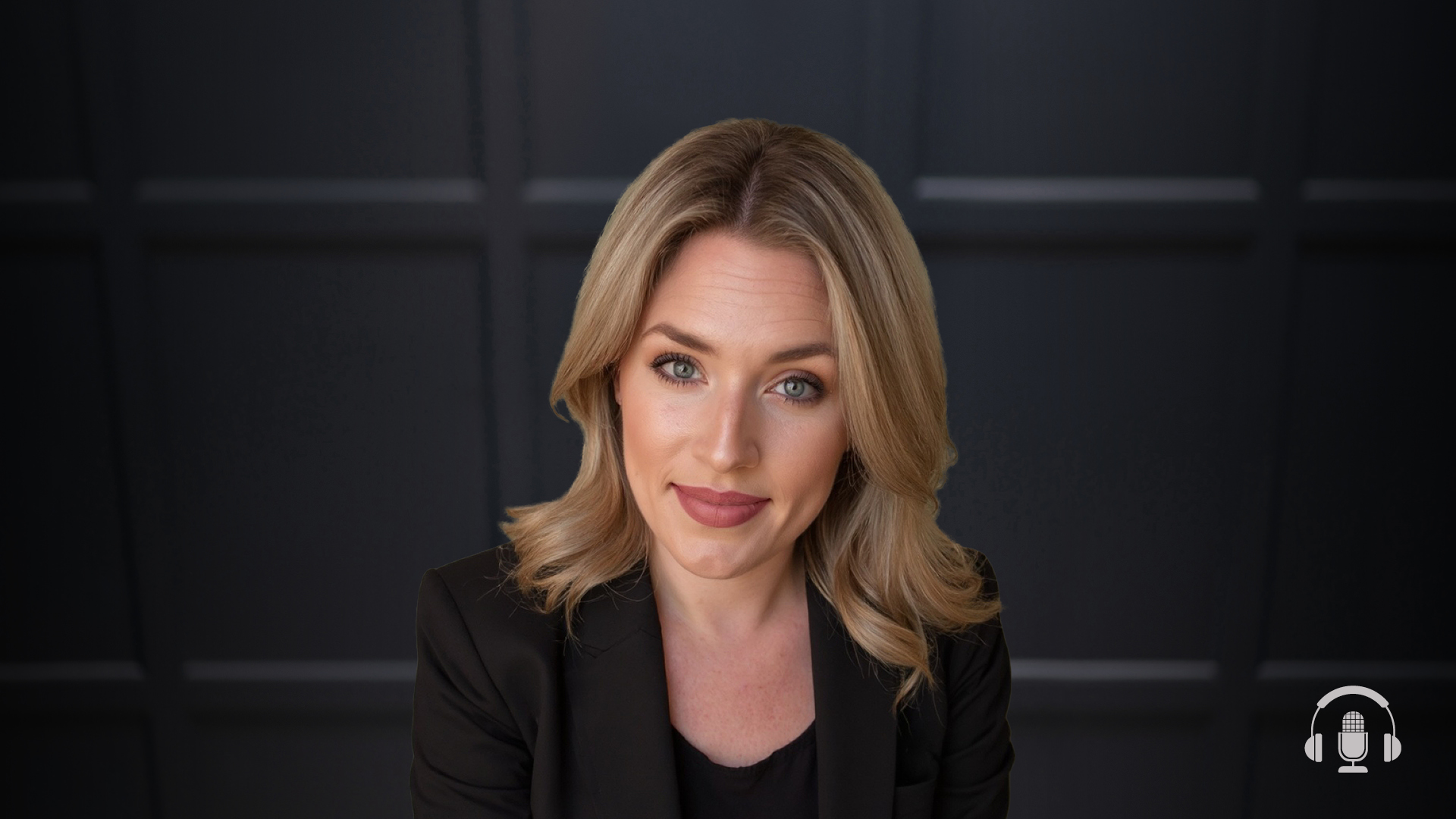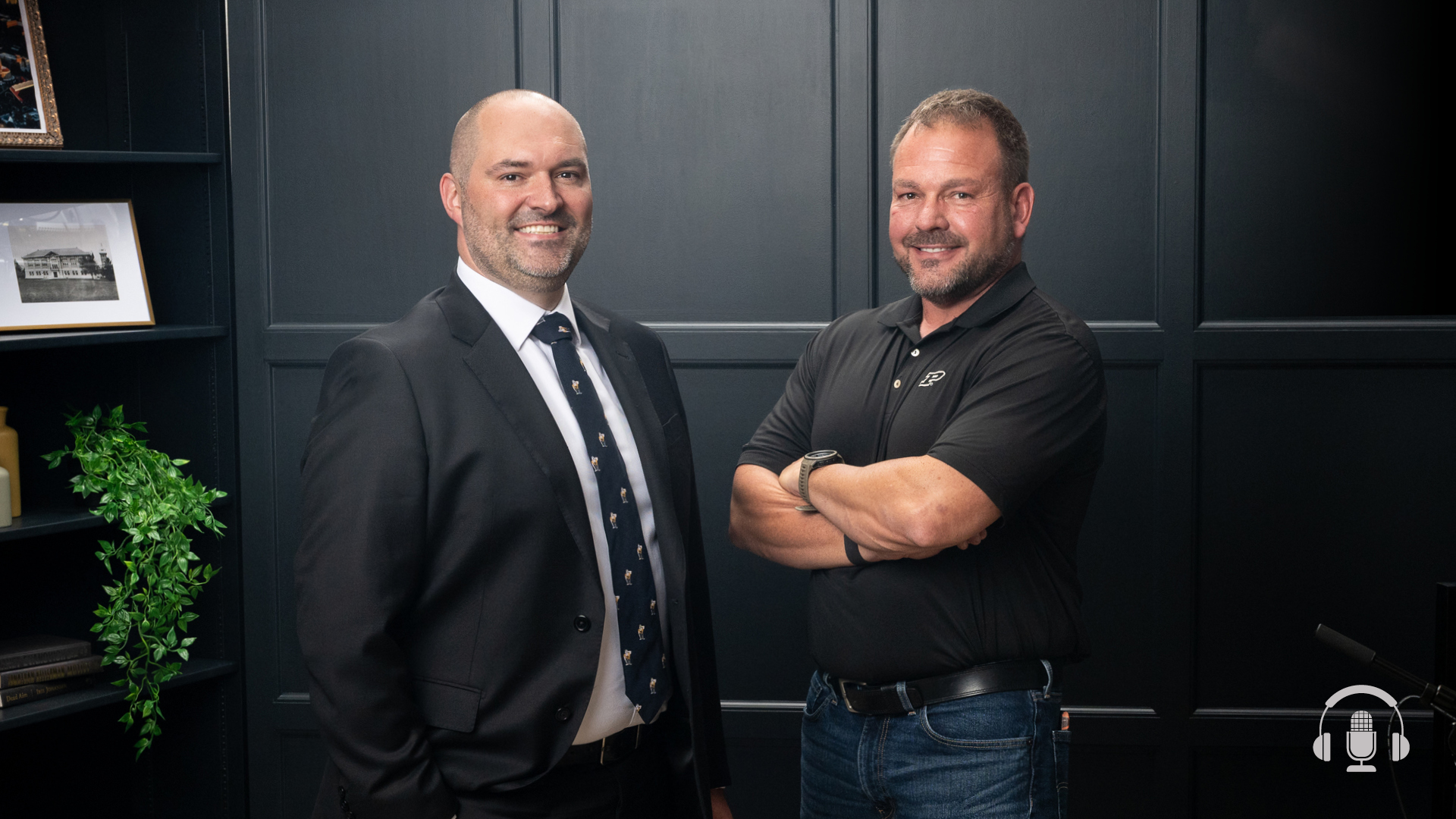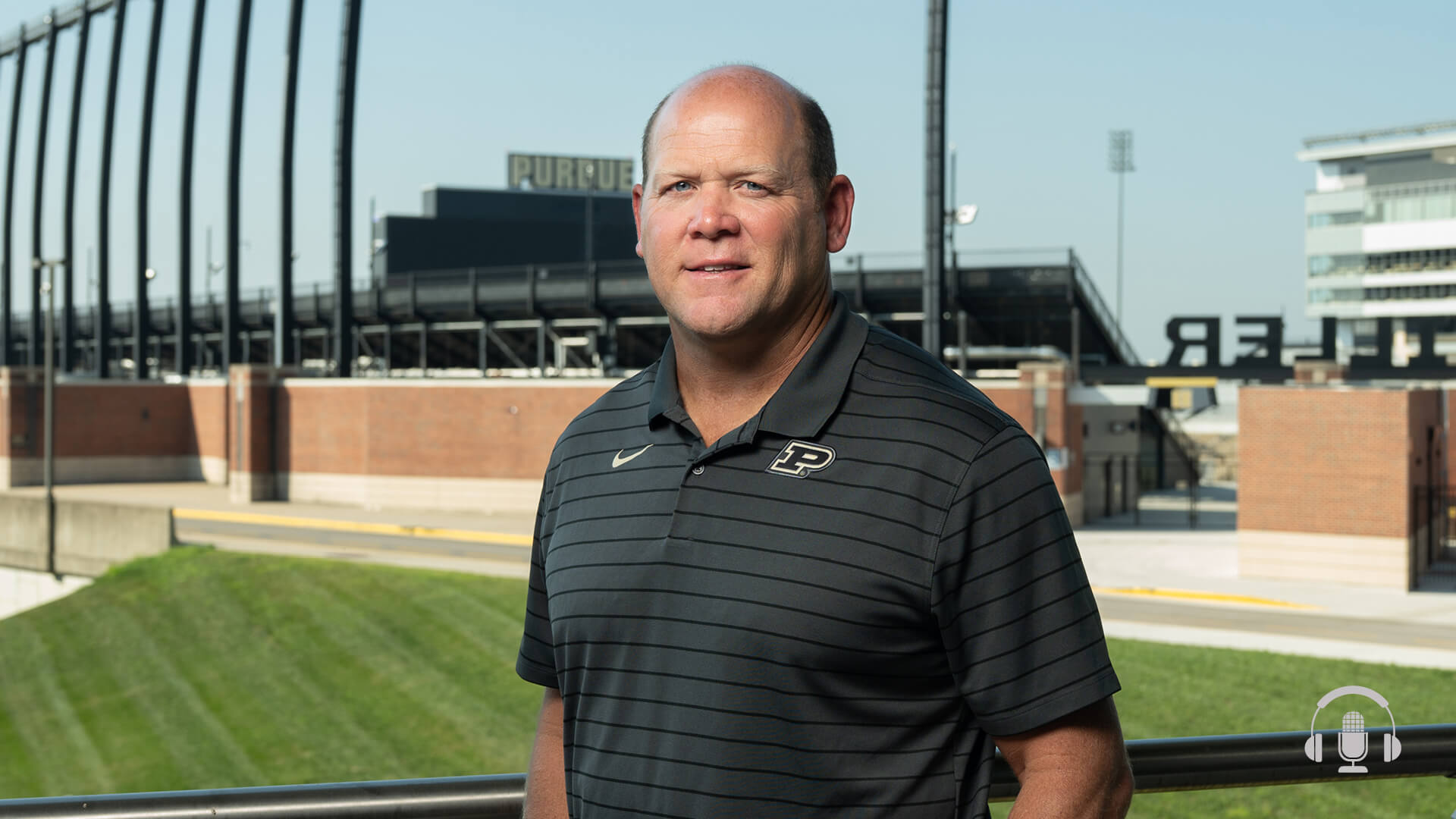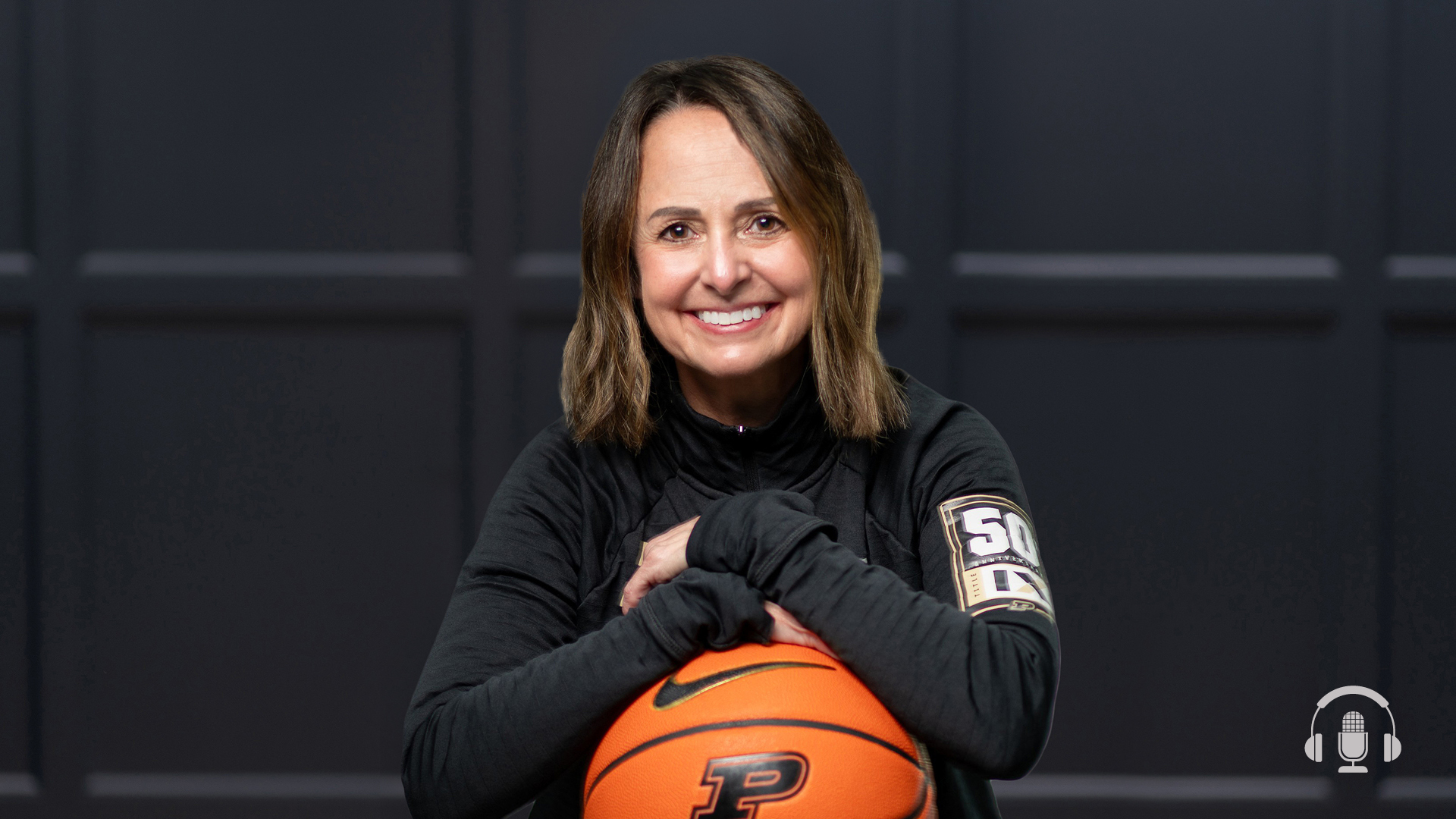Podcast Ep. 77: Fighter Pilot Heather Penney Reflects on Purdue Journey and 9/11 Mission
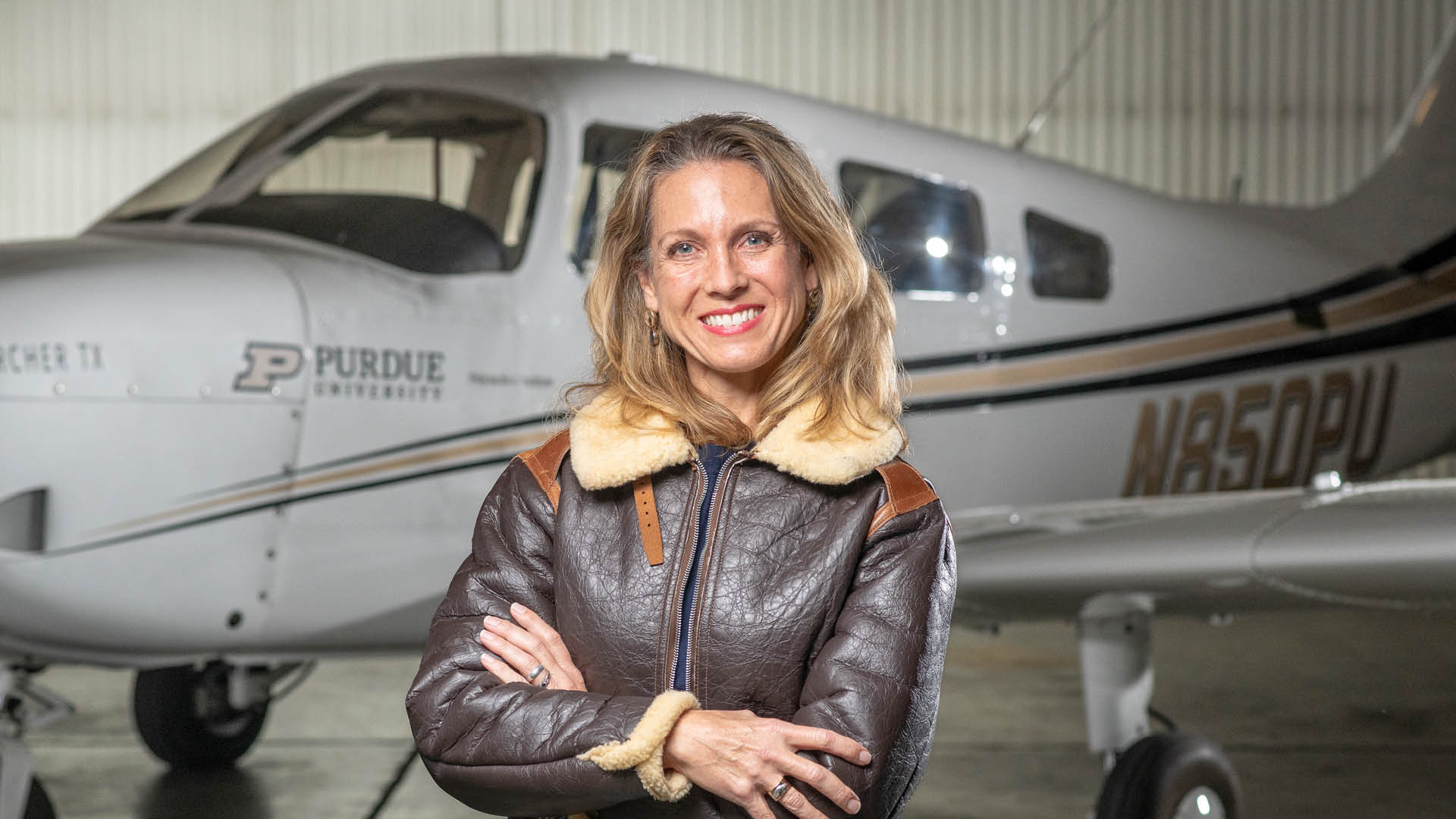
In this special episode of “This Is Purdue,” we’re talking to Boilermaker and former D.C. Air National Guard fighter pilot Heather Penney.
Listen as Heather (BA English ’95, MA American studies ’97) shares her incredible story from 9/11, when she was prepared to make the ultimate sacrifice with her flight lead, Marc Sasseville. She reflects on the events of that historic day, from being selected to complete the mission to stop the hijacked United Airlines Flight 93 to being grounded after hours of time in the air to how she feels about that day now, more than 20 years later.
Heather also expresses her gratitude for her time at Purdue, where her passion for flying blossomed further, and shares more about her experience training to become one of the nation’s first female fighter pilots.
Goosebumps. That’s what you can expect from our episode featuring this brave and relentless Boilermaker.
- Learn more about Heather Penney’s story here
- Learn more about Purdue’s College of Liberal Arts here
- Check out Heather’s official website here
Full Podcast Episode Transcript
Heather Penney:
This is Heather Penney, and you’re listening to This Is Purdue.
Kate Young:
Hi, I’m Kate Young, and you are listening to This Is Purdue, the official podcast for Purdue University. As a Purdue alum and Indiana native, I know firsthand about the family of students and professors who are in it together, persistently pursuing and relentlessly rethinking, who are the next game changers, difference makers, ceiling breakers, innovators?, who are these Boilermakers? Join me as we feature students, faculty and alumni, taking small steps toward their giant leaps and inspiring others to do the same.
Heather Penney:
That morning on September 11th was like every other American that morning. It was totally ordinary and every day. I woke up. I put my flight suit on. I ate my Cheerios. I kissed my dog goodbye, and I drove off to work. There was nothing special about that day. But I do remember, on the East coast in DC, and it was in New York as well, how crystal blue the sky was. Not a cloud. No haze. It was deep and blue as far as you could see. No one had any idea what was going to happen.
Kate Young:
What you are about to hear is like a story straight out of a movie, but it’s the story of a real life Boilermaker. In this episode of This Is Purdue, we’re talking to proud Purdue alumna and former DC Air National Guard Fighter pilot, Heather Penney.
Heather discusses her gratitude for her time as a student at Purdue, where her passion for flying blossomed further and her experience training to become one of the nation’s first female fighter pilots. She also shares her incredible story from September 11th, 2001, when she was prepared to make the ultimate sacrifice with her flight lead, Marc Sasseville. You’ll hear Heather reflect on the events of that historic day, from being selected to complete the mission to stop the hijacked United Airlines Flight 93, to being grounded after hours of time in the air, to how she feels about that day now, more than 20 years later.
Heather came back to Purdue in the fall of 2022, and we had the opportunity to shoot this interview right inside a Purdue airport hangar. If you are thinking to yourself, wow, that would be really cool to see, you can see it on our podcast YouTube page. Our full video interview with Heather is posted there now. Trust me, you do not want to miss it. You can expect goosebumps from this special episode featuring this brave and relentless Boilermaker, and we are so incredibly proud to release this inspiring episode to kick off Women’s History Month.
But first, let’s start with Heather’s journey to Purdue, and why she had such a passion for aviation from a young age.
Kate Young:
Heather, Thank you so much for joining us on This Is Purdue. We’re thrilled to have you here.
Heather Penney:
Oh, I’m so thrilled to be back. I love Purdue, so thank you. This is going to be so much fun.
Kate Young:
Thank you. Yeah, we’re very excited. So tell us about your journey to Purdue. What made you come here? You’re not from this area, right? So how did you find out about Purdue?
Heather Penney:
That’s right. No, I’m not a local. As a matter of fact, I was growing up in Nevada and then Colorado, and going through the search process, Purdue came up on my horizon because of just the quality of their academics. And they had an airport. Originally, I thought I wanted to go into aerospace engineering, and as you know, I mean, Purdue holds one of the premier aerospace engineering departments in the world. It was affordable. It was excellent. And to be honest, I need a little independence from my parents, so crossing state lines might have been part of that too.
Kate Young:
Sure.
Heather Penney:
But no. I mean, in many ways, some of the decisions we make about our lives and the vectors that they take, they might not seem as monumental as they end up being. But I can’t begin to describe how important it was to my life’s path that I came to Purdue, and how grateful I am that I did.
Kate Young:
How do you feel being back here on campus?
Heather Penney:
It’s wonderful. It’s wonderful to see how the campus has grown, how it’s evolved, how it’s changed, how so many of the things that were really special to me as a student, both are enduring, as well as changing, because a student body is different today than when I went to school. And so I think it’s great that Purdue, it’s continuing to stay relevant to the needs of the students today, while it’s still maintaining those touchstones that are really important to all of us, and as I said, are enduring.
Kate Young:
So when you got to Purdue, did you already kind of have that passion for flight from your dad, or did you develop it at Purdue? Tell us about that.
Heather Penney:
I’ve been crazy about airplanes ever since I was a little girl, and I think I come by it honestly, right? I mean, because my dad’s a pilot, a fighter pilot, and so I grew up around all that. But I’m also a third generation pilot. His father was a pilot, which was partly how he became enamored with the miracle of flight, the joy of flight. So I grew up around aviation. I grew up around airplanes. I grew up seeing my dad fly, and there was really little more that I wanted to do than to be that.
Kate Young:
Heather shares more about her experience within the College of Liberal Arts, her Purdue mentors, and her favorite memories as a student.
Heather Penney:
I am so grateful that I went through the College of Liberal Arts because, at the time I went and I got an English degree, because I had a passion for literature, and it was something that I really enjoyed in high school. I wasn’t really sure what I wanted to do with that. But what I’ve discovered is that, what we do in the liberal arts, the School of Liberal Arts is actually should be the school of cognitive learning, because what it teaches us to do is how to think about problems, how to decompose and deconstruct issues, how to synthesize, how to recognize patterns, how to really do that analysis at the qualitative and the quantitative level, very different from engineering. Engineering is a specific skillset, very different than the scientific process.
What liberal arts teaches all of us, no matter what discipline we’re in, are those critical thinking skills that we need to have for the more fuzzy, messier parts of life, which, to be honest, is what most of us do on our daily basis. So I can’t imagine a better college to have gone to, better discipline and training to have gone to, that could have prepared me for what I’m doing today.
Kate Young:
And what was one of your favorite memories at Purdue? Do you have any that really stick out or a couple that you want to share?
Heather Penney:
Oh, goodness. All of us that have gone through Purdue, especially having done my bachelor’s and my master’s here, so many excellent memories. Being part of the first Air Race Team for Purdue and standing at that team is really important to me, especially having seen where the students who came in after me took that team, that organization, and also the fact that Purdue, the team that I raced on with Krystal Lewis, she was the pilot, that what we did there was the pioneer for all college teams perform, getting to participate in race within the Air Race Classic. That’s especially important to me.
I do have to say the faculty is another key piece of my favorite memories, how personal the faculty were. I mean, just how involved they were, not just in my classes, but in my life and helping me find direction, helping me take that next step, providing that kind of encouragement. And we all have developed enduring relationships from the friendships that we have here.
The other thing that I think is really important that is a special memory from Purdue, and you’ll laugh at this, it was my time as a waitress at a diner called Utopia, which is no longer a business. What I did there was I learned a work ethic that no job is beneath you. And I enjoyed it. And I got to interact with the student body from all across campus. And so it was part of just being involved with who we are as Purdue that was really important.
Kate Young:
I always say, everyone should be a waitress or a waiter at some point in their life.
Heather Penney:
Yes. Exactly right.
Kate Young:
You learn how to deal with everything.
Heather Penney:
That’s right. Yeah.
Kate Young:
So tell us more about you and Krystal flying in that competition, and I imagine people are still doing it from Purdue today.
Heather Penney:
Oh, yes. Purdue is still racing today, and they have an excellent winning record. I mean, I don’t know how they placed this year, but I know that they’ve placed in the top 10 multiple times, and they might even be one of the winningest university teams in the race. But getting to do that with Krystal is really special, certainly because one of the things that Purdue did was they connected us with some of the women Air Force Service pilots who were also racing. So they were our mama birds and we were their baby chicks. And to get the mentor from those women was just incredibly special because of what they had done, how they had served our nation in World War II, and then how they were passing it forward to us.
And the chance to be able to go race with Krystal. She is just fantastic. She is a total professional, very focused, very competitive, but also just a ton of fun. And she has gone on to be very successful in her aviation career as well. So what better place than Purdue to launch us?
Kate Young:
Absolutely. Do you have any favorite professors, as you look back or any other mentors? You mentioned those women that you flew with, but anyone else that comes to mind?
Heather Penney:
I would say Dick Thompson, Bob Lamb and Susan Curtis were really key in my development. Dick Thompson really helped turn me into who I could become. He fostered my intellectual curiosity. He encouraged my spunk. I was a little wild, I was a little spunky, but he loved that. He helped me channel that in a really productive way. Susan Curtis and Bob Lamb encouraged me to take my GRE, go into graduate school, and that was a really key stepping stone for me in terms of honing my critical thinking abilities, honing my writing abilities. Then they also really supported me in my move to the Air Force.
Kate Young:
In 1993, while Heather was getting her master’s in American Studies at Purdue, she learned that Congress and the Department of Defense had eliminated rules barring women from flying combat aircraft. Later in 1996, the DC Air National Guard invited her and nine other pilots to interview out of a field of more than 300 applicants. From there, they selected only two, and one of those two was Heather Penney. I asked her more about this time period and what was going through her mind after this historic announcement.
Kate Young:
So when you were getting your master’s here, it came out that women could now be fighter pilots. What were you thinking at that time? What was going through your mind?
Heather Penney:
Yes. Yes. At the same time, I was like, am I good enough? I mean, I was in graduate school for liberal arts. Failed engineering student. I really loved the math. I was not good enough for the computer sciences, and I just have to just be frank in a bit. But I was liberal arts. Did liberal arts students go off and become fighter pilots? But yes, they do. And again, I really have to thank Bob Lamb and Susan Curtis and Dick Thompson. They all were incredibly supportive. I don’t think that was the path that they had planned for me, but they knew that that had always been a passion for me, and their support helped me make that pivot.
Kate Young:
Heather went on to train to become one of the first American women to fly the F-16, and her training class’ only woman. So what was that experience like for Heather?
Heather Penney:
Everyone’s competing against each other. At the same time, we’re also working to support each other. We have a term called cooperate and graduate, and that’s not about cheating. That’s about supporting each other through the process. That’s studying together. That’s being encouraging and supporting of each other, noticing when someone’s struggling and, “Hey, what can I do to help you out?” Going through pilot training, which is the most competitive element of this, they were utterly fantastic, both the students and my instructor pilots, and again, going through my B course for the F-16, the basic course where I learned to fly and earned my qualifications to fly the F-16.
But to be honest, going into the fighter squadron was a little bit more challenging because that’s where I was truly the first and only female fighter pilot in my squadron. There was a group of guys that, to be honest, did not want me there and actively tried to undermine me. There were a small group of guys that were totally supportive, because why not? And then there was a large in the middle, saying, “Well, we’ve never seen anything like this before. Let’s see how it happens.” And so it was my job to win them over with my performance, to be the best that I could possibly be, and prove to them that I deserved to be there through my knowledge, my skill, how well I knew the jet, how well I flew the jet, how good of a wingman I was. That helped, I think, proved to them that, yeah, who cares if she’s a girl. Validated the guys that were the initial supporters, and ultimately one over the guys that initially didn’t want me to be there.
Kate Young:
What would you say your biggest challenge was throughout that time period?
Heather Penney:
It was understanding and navigating the social elements of the fighter squadron, because I always say, the jet doesn’t care if you’re a man or woman. It just cares if you know your stuff and has the right, and if you’ve got the right stuff. But the squadron is fundamentally about people and the organization, the culture of that organization. So navigating that was my biggest challenge.
Flying the jet, learning the tactics, going out on our sororities, that was not the hard part. The hard part was, to be honest, it was very lonely at times, because in some ways, it was culturally risky for the individuals that supported me to mentor me because I was the only woman. And so it could be very lonely, and that was hard, but it was the social piece of figuring out, how do I navigate this environment, because it was a very different culture that I had never experienced before.
Kate Young:
What advice would you give, you’ve been through this, to any females, whether it be flight school, fighter training, or just engineering? A lot of females are outnumbered. What advice would you give to them?
Heather Penney:
First of all is, ultimately, it comes down to performance. I never cared that I had to work twice as hard, that I had to be 150% in order to be compared with my male colleagues, because I wanted to be the best anyways, so that didn’t matter to me. Was it unfair? Sure. But life isn’t fair, so stop whining about it and get to work. And that ethic, I think, is really important, because it then proves your credibility, and it proves that you have earned the right to be there. It’s hard, but that’s also why it’s important that, as a woman, you need to identify who your allies are and reach out to other women as well, because developing those relationships is really important to keeping your heart and your soul alive when you sometimes have to go through hard things.
To be honest, a huge piece of our success, in any career, in any discipline, is how we navigate those social environments. Organizations are fundamentally made of people. You can be as technically competent or technically excellent as possible, but if you cannot navigate the human landscape, there will be limits to your potential. So it’s really important to establish those relationships, to establish those friendships, and support each other so that you can learn to navigate successfully those organizations.
And for leaders of those organizations, it’s important that they maintain their cultures to be mission purposed. Every organization has a culture, and that’s important because that allows us as team members to trust each other, to be aligned with what our mission is, with what we’re going to go do. And there are behaviors, norms, codes, beliefs, and actions, and traditions that are associated with all that that make us successful. Leaders have to be very aware of how that culture is mapped to their purpose. Because if they begin to allow that culture to diverge, that’s when the performance of the overall team goes down. So for example, a lot of the super macho dudes that didn’t think I should be there just because I was a girl, that’s an example of culture creep. What does being a girl have to do with putting bombs on target on time?
So I was very fortunate that the squadron commanders that I had J.C. Witham, Marc Sasseville, they actually were very focused on, look, we’re fighter pilots. And yes, we’ve got certain norms and codes and beliefs and cultures, we are very focused on making sure that those are mapped directly to our mission purpose. And when you do that, as long as everyone is bought into those values and codes and behaviors, it actually creates the space for diversity because, hey, I believe in all of the norms that we believe in as fighter pilots, and I’m going to do my best to adhere to that because I believe in it. So does it matter if I’m a girl? No. So that’s actually one of the really neat things is when we focus on the mission, and we create a culture that supports that mission, we actually create the opportunity for diversity and inclusion.
Kate Young:
I so admire Heather’s spirit. Like I said at the beginning of this episode, she is the perfect Boilermaker alumni to celebrate during Women’s History Month. After Heather completed her training and joined the 121st Fighter Squadron, her colleagues gave her her call sign. Lucky, as in Lucky Penney. By the way, you don’t get to choose your call sign. Heather explains the process that goes into receiving your call sign.
Heather Penney:
Getting your call sign is a rite of passage.
Kate Young:
Okay. I was going to ask, who chooses it? How does that work?
Heather Penney:
You do not choose it.
Kate Young:
Okay.
Heather Penney:
The squadron gives it to you.
Kate Young:
That’s kind of more fun, right?
Heather Penney:
Well, it’s more fun, but actually, it’s a rite of passage because you don’t get a call sign until you have become combat mission qualified. So as a young wingman, you get qualified in your airplane, but you’re not combat mission qualified. You’re not around. If the balloon goes up, you get left behind. So you still have to go through training. And through that training process, the squadron gets to know you, who you are. There’s plenty of opportunities to do stupid stuff. And then when you pass your certification and get that combat qualification is when you are formally recognized as a fighter pilot and a member of the unit. So receiving your name is a very symbolic act. And it’s either play on your last name, some kind of acronym, or some word that refers to something foolish or stupid that you did, to keep you humble.
And you don’t get to choose your name. You really don’t get to get renamed. But every fighter pilot is attached to their call sign because it’s that moment of recognition. It’s that moment of arrival. It’s that moment of becoming. Because before then, you’re just an FNG, a friendly new guy. You’re not really named or acknowledged. So it’s really special. Better lucky than good. And I was very fortunate. Before I became combat mission ready, I got to do a lot of neat deployments with the squadron. And so my timing was also very lucky. But I’d rather be better lucky than good any day.
Kate Young:
And so the people who get the name when they were 25 and made a stupid mistake, it lives with them forever.
Heather Penney:
Lives with them forever. But you can get renamed by your squadron if you do something even stupider.
Kate Young:
Oh God.
Heather Penney:
So the hazard is never gone.
Kate Young:
That’s amazing.
Kate Young:
I’m going to transition here to the bulk of my conversation with Heather “Lucky” Penney. It’s her personal story from September 11th, 2001. When she was just 26 years old, Heather embarked on a flight that would ultimately change her life.
9/11 means a lot of different things to a lot of different people. It’s one of those moments in history where you remember exactly what you were doing, the exact place you were when you first heard the news. For me, I was sitting in a sixth grade Home Ec class, and I vividly remember our middle school principal coming over the PA system and telling teachers not to turn on their TVs for any reason. We all knew it was an unusual request, and we could all hear the panic and horror in his voice. I remember the fear, anxiety and confusion that surrounded us the rest of the day, as we started to learn a few more details about what was happening in New York City.
For Boilermaker Heather Penney 9/11 marked a journey that she met with pride and bravery. Heather was chosen for a unique mission. It was a suicide mission. She and her flight lead, Marc Sasseville took, off from Andrews Air Force Base in unarmed F-16 fighter planes, intending to crash into the hijacked United Airlines Flight 93 on the morning of 9/11. You see, if the two had found Flight 93, which was on its way from Newark to San Francisco, but had veered back toward Washington DC, their mission would’ve been to crash their fighter jets directly into the plane to prevent it from reaching our nation’s capital. Here’s Heather’s story.
Heather Penney:
That morning on September 11th was like every other American that morning. It was totally ordinary every day. I woke up, put my flight suit on. I ate my Cheerios. I kissed my dog goodbye, and I drove off to work. There was nothing special about that day. But I do remember, on the East Coast in DC, and it was in New York as well, how crystal blue the sky was. Not a cloud,. No haze. It was deep and blue as far as you could see.
Kate Young:
No idea what was about to happen.
Heather Penney:
No one had any idea what was going to happen.
Kate Young:
Tell me about when you got that call. What were you feeling? How did that obviously change your life?
Heather Penney:
We were in a scheduling meeting. I was not scheduled to fly that day, although I desperately hoped that I would have because I loved flying. I was a young wingman. My job is fly, fly, fly. But I’m in the scheduling meeting. One of our enlisted troops, David “Chunks” Callahan, just comes walking in and says, “An aircraft hit the World Trade Center.” And so we all got up and we walked to the squadron bar where our television was, and that’s where we saw the images that everyone else saw, of the towers burning and the replay footage of the airliners hitting the towers.
We knew we had to get airborne, and we knew we had to protect. But the problem for us was that as the DC National Guard, we didn’t have the chain of command that could authorize us to launch. And the other problem is that, because we were not on an alert unit, the United States, after the fall of the Soviet Union, had just cut the Air Force in half literally and dropped all of our alert units. We didn’t have any missiles. We had no live ordinance on board. So we had two problems. We had to get the authorization to launch, and we had to get live weapons on the aircraft.
Kate Young:
Did anyone ever think it was an accident maybe that someone flew into the World Trade Center, or you guys knew?
Heather Penney:
When Chunks said the first time, “Hey, an airplane flew into the World Trade Center,” we looked at each other and we’re like, how does that happen? We thought it was a light aircraft, just flying up and down the Hudson and took a wrong turn and bounced off a building. We didn’t take it seriously until he came back the second time and said it was on purpose. And that was when we saw the images. It was very clear. This could not be an accident. It was very clear that our nation was under attack.
Kate Young:
And how did they choose who was going to go up there? How were you chosen to do that?
Heather Penney:
In the squadron that morning, we had a very skeleton crew because we had just come back from a long deployment. And as a guard unit, most of our pilots were part-timers, so their airline pilots, they were off on their jobs. As a matter of fact, we only had enough personnel in the squadron to send a three-ship. We normally send eight ships off to train that morning.
Marc Sasseville was our director of operations. He was our senior leadership within the squadron that morning. And he was not going to let anyone else lead that mission, because when the call came, we knew it was going to be a suicide mission if we were successful. And he has a gorgeous wife and wonderful, adorable children, but he was not going to lead from behind. I would love to think that he picked me because I was a good wingman, but I think, honestly, he probably picked me because I had no family. I didn’t have a spouse. I didn’t have any children. All I had was my dog. And so I think that was why he chose me, because he told “Raisin” Dan Kane, and Brandon Rasmussen, his call sign is Igor, and they both had families. They were to wait until they had missiles on board. I believe that’s why Sass selected me.
Kate Young:
How did you feel when he selected you? What was going through your mind?
Heather Penney:
I did not want to get left behind. None of us did.
Kate Young:
So everyone was eager to go.
Heather Penney:
Everyone was eager to protect and defend. That is our oath. That’s why we exist. I was grateful that he selected me.
Kate Young:
What did it feel like getting in that plane that day?
Heather Penney:
Can I say this?
Kate Young:
Yeah.
Heather Penney:
Don’t fuck it up. If anything mattered at that moment in time, it was getting it right. I wasn’t trained for this. I mean, we don’t train to do suicide missions.
Kate Young:
Sure.
Heather Penney:
I had never been taught how to scramble an airplane. And since then, obviously I have, because we now have an alert unit, but the airplanes weren’t ready. They weren’t hot cocked, so we had to make up our procedures on the fly. I was taxiing. My radar wasn’t awake, my missiles weren’t awake. I didn’t have a navigation platform. I wasn’t even strapped into the jets, so I couldn’t have ejected, right? I didn’t even have my seat belts on. But all that mattered was that we got out there as soon as we could and that we found the airliner that we believed was inbound. Unfortunately, the passengers on Flight 93 had already taken control of the airliner, had already crashed it.
Kate Young:
What was going through your mind when you knew that it was a plane crash and you couldn’t do anything more about it?
Heather Penney:
We didn’t find out that Flight 93 had been downed. Sass took us out, I don’t know how far, because I didn’t have navigations. Probably a little over a hundred miles. We went out to the northwest over the Pennsylvania countryside. We didn’t see any smoke, which is surprising because we should have, but I don’t recall seeing any smoke. And then turned us around. Because we had sanitized the airspace. And we couldn’t afford to go any further out because if we were even just a little bit off on our access, we could have allowed the airliner to flank us, and we didn’t know that it was down. So once we had sanitized the airspace from the direction that we believed the airliner was coming from, Sass took us back to DC to fly the combat air patrol. And then we set up a combat air patrol with a counter rotating cap centered over Reagan National.
And then the quits from Langley, some F-16s who were flying alert from Langley, showed up. They capped up at 18,000 feet and they had missiles. So then my anxiety started to go down. And then Igor and Raisin got airborne, and so then we switched up the Cat from there. Potomac approach was phenomenal. This is just an amazing story of how ordinary people rise to extraordinary circumstances. Stealing that quote from Admiral Halsey, Bull Halsey from World War II.
Potomac approaches air traffic control, and their normal job is to separate airliners and put them all on little highways to take them down for safe landing. And now here, Sass and Raisin are asking air traffic control to bring aircraft together and start talking fighter pilot language and using military speak. And they pivoted and did that immediately. They were so mentally agile, and then they started calling out tracks and telling us who they were and where they were going. So they helped make sense of what was a confusing airspace, and they were just utterly fantastic. So how people pitched in and began to make it all work, even though none of it was planned, it was all ad hoc, but people just did what needed to be done.
Kate Young:
How did you feel when you finally landed or on the ground again?
Heather Penney:
I really had to pee.
Kate Young:
How many hours?
Heather Penney:
Like four.
Kate Young:
Oh, wow.
Heather Penney:
Because we tanked.
Kate Young:
Okay.
Heather Penney:
And we were waiting until they had more missiles to put on the second load of jets for us to take up. And we also had to wait for another two-ship to launch and relieve us. So it was some time before we were able to land. I don’t know the exact hours, but my bladder was certainly stressed.
Kate Young:
So then once you were on the ground, did you know that you were staying on the ground? Did you think there was a chance that you could go back up?
Heather Penney:
No, we had to launch again. We were skeleton crew, so they were going to fly us until they had enough pilots to sustain another go and then another go. And what was amazing is, by the time we landed, our enlisted crew, Sandy Campbell, she was our Chief Master Sergeant, we called her “Witch”, she was fantastic, she already had cots laid up everywhere. There were multiple thermoses of coffee. She started a buffet line for people, because she just transitioned us directly into 24/7 operations. But I knew I wasn’t going to get to go, “Whew. That was a close one, and go home.
Kate Young:
Exactly.
Heather Penney:
We were going to continue to fight the fight until we could reach stabilized operations. And so Sass and I were whisked off to go brief the leadership of the National Guard, and then brought us right back to jump into another set of jets to take off again.
Kate Young:
So what was that work day? How many hours until you got to sleep?
Heather Penney:
I have no idea. I have no idea. But on that second sortie is when President Bush came back. And so Sass and I were given the task of intercepting Air Force One, and then helping with the escort because he did have dedicated fighter escort. But in this kind of scenario, we had no idea what other things might be planned. And so, trying to provide beefed up air security for him coming back was a priority.
Kate Young:
What was that camaraderie like that day?
Heather Penney:
I’m not really sure I would call it camaraderie. We were just getting the job done. And we were all in it together, and we were taking care of each other, but we were focused on the mission.
Kate Young:
And when did kind of the pieces start falling together? What had happened? When it was safe? How did that go?
Heather Penney:
For me, my second sortie was anticlimactic because now I had missiles, so I know what to do with this. But we were all really uncertain for weeks, and I think the entire nation was. We didn’t know what was the scale of the threat, what was the potential for additional attacks. And so we were all prepared for anything that might happen.
We were also working to transition and stabilize the Combat Air Patrol and pass that authority over to the active duty Air Force, because we had been operating and owning it, if you will. And so Jeff Johnson “Tuna” Johnson, he was our ops group commander at the time, was in the process, and he was working all of those details, in addition with Dan “Raisin” Kane, our weapons officer, Marc Sasseville, J.C. Witham, who is our squadron commander, doing all of that work to normalize those operations. But for us, for all of us normal guys in the squadron, we just moved into 24/7 combat air patrol operations. So my life was midnight to 4:00 AM was my time in the sky, and I did that for nearly a year.
Kate Young:
We talked about your dad earlier. So he was a commercial airline pilot at this time, so he could have been in that plane that you went up and were targeting, right?
Heather Penney:
There could have been a possibility that my dad was flying the United Airlines flight that we were targeting. As a matter of fact, one of his close friends and colleagues, Jason Dahl, was the captain on Flight 93, that my dad had worked with when he was in the United Training Center. But to be honest, I didn’t put that together that day. Certainly, I was thinking about other things. My mom was the one who began to see, that could have been. It never crossed my mind at the time. And honestly, even if it had, it would not have made a difference.
Kate Young:
You had a job to do.
Heather Penney:
Yes. And my dad, as an airman, an Air Force officer, he would’ve expected nothing less.
Kate Young:
Walk us through how you decided to come out with this story, because you kept it private for, what, 10 years?
Heather Penney:
I didn’t talk about that day for 10 years because I didn’t do anything. We, Sass and I were a mission failure. There was nothing special about us. On the 10th commemoration, the National Guard Bureau asked Marc Sasseville to talk about the DC Guard’s response, and he asked me to tell my side of the story with him as his wingman. I mean, Sass is the real star of that flight, right? He’s the flight lead. He’s the guy that actually knows what’s going on. I’m a green wingman. I’m a young guy. I’m following him. And that’s when I began to tell the story, and really began to reckon with what that day meant, what it meant to me, and I think what it means for our nation.
Kate Young:
Had you two ever talked about it together prior to that, or it was just kind of-
Heather Penney:
No.
Kate Young:
Wow.
Heather Penney:
We never talked about it because things got busy. We had combat air patrols to do. We had a war to go off to. We had another deployment and things just got busy and it wasn’t special.
Here’s the other thing too. Yes, Sass and I were prepared to go off on a suicide mission, but anyone, anyone, would’ve been willing to do the same thing. And in reality, the passengers on Flight 93 did. They were just ordinary everyday Americans. They had not raised their hands and sworn an oath of service like Sass and I had. So I don’t think Sass and I view what we were willing to do as special. We just happened to be in the wrong place at the wrong time, or the right place at the right time, however you want to look at it. So there was nothing to talk about.
Kate Young:
How does it feel talking about it now? Is it therapeutic? Is it hard for you?
Heather Penney:
It is always emotional for me and not because of me or coulda woulda shouldas. I do experience deep regret, not survivor’s remorse, but deep regret, that our organizational structure and the chain of command and the preparation of our country, that we were so complacent that we were ill-prepared and placed the passengers of 93 in a position where they had to make the choices that they did. But I am also intensely grateful and inspired by the fact that they did, because it shows me that our American spirit is not dead, and that we still understand that there are things in this world that are more important than us.
And so when I think about that day, it’s not cathartic. It’s not traumatic. But what’s important to me is that… The images are sensational. They’re horrifying. But we shouldn’t live there, because the real lesson of 9/11 should be in all the acts of heroism, no matter how small, of how people rose to the occasion and did what needed to be done and took care of each other. Their spirit lives on in each and every, and that should be our real legacy.
So it’s important that we don’t just voyeuristically sit in that sensational self-righteous trauma, but that we turn it into something that can truly honor their sacrifice.
Kate Young:
I’m sure after hearing this, it wouldn’t surprise you that our entire podcast team was in absolute awe of Heather and her story. It was so silent in that airport hangar, you could hear a pin drop. We were all mesmerized by her courage, her persistence, her humanity.
And speaking of that persistence, I wanted to know if Heather ever felt nervous or worried to fly after that historic day. Did anything that happened on 9/11 prevent her from getting back out there and heading right back up into those skies to protect our country?
Heather Penney:
No. Again, I flew a second sortie that day, and I went out the next day and next day and next day and continued to fly. There’s something about flight to me that is so transformative. It’s so freeing. It’s so joyful. It’s so challenging. I mean, I truly think that flying forces us to be the best of who we are. No flight is ever the same. No flight is ever perfect. Every flight forces us to strive, to hold ourselves accountable to try harder to grow, and yet at the same time is totally transformative. And I’ve flown all over the country, one of the things I… And a small airplane at low altitude, and so I get to see the heartland as I fly over it, down the mountains, and it helps me feel connected to America in a different way. And there’s so much just sheer joy to me in flying. I could never give it up.
Kate Young:
How often do you fly today with your three planes?
Heather Penney:
As much as I can. I fly mostly vintage aircraft. So we have a World War II Stearman. It’s an open cockpit biplane that was a trainer for World War II pilots, so the greatest generation. And we actually know that our particular aircraft flew at Sweetwater, Texas at Avenger Field with the women Air Force Service pilots. We discovered this after we bought the aircraft. So there’s a really neat connection there for me between the WASP and my own service. We have a Cessna 170 from 1950, so that’s a little small tail dragger as well. And then we also have a Bücker Jungmann, which is actually a Luftwaffe trainer. The design is similar to the timeframe of the Stearman, and it’s a little open cockpit biplane as well. Very, very aerobatic, very nimble, a ton of fun to fly. And so it’s interesting to see the different philosophies of design between America and Germany at the time, although Bücker is a Dutch company, between how they thought what a primary trainer should look like. So those are the three aircraft we have.
Kate Young:
And so Heather continues to fly, again, and again, and again. But what is Heather up to today after she retired as a fighter pilot?
Heather Penney:
When I left the Fighter Squadron, I was a single mom with two little girls at the time, and I was fortunate to be working for Lockheed Martin. And so I worked with Lockheed Martin in their Washington operations section for over 10 years, before making the transition to where I am today at the Mitchell Institute for Aerospace Studies.
Now, the Mitchell Institute is a think tank, focused on national security, defense issues, air force issues, anything having to do with air power. And so that really is kind of my passion in life. And I love what I do because I’m not in a lane for what I can do. I can be as curious as I need to be or want to be, but what I’m doing is, I’m addressing issues having to do with advanced technology, future warfare concepts, policy issues that are affecting airmen today, and the defense industry, innovation and so forth, having to do with stuff from data rights, the industrial base, to how we use information to… I just finished a study on how humans should team with autonomous combat aircraft. It spans a lot of different things.
And what’s important to me is, in my mind, I’m passionate about this work because it’s important that the airmen that come after me are not placed in the same situation that I was on 9/11. That we as a nation owe it, it’s a moral obligation, to our service members to ensure that they’re appropriately equipped, that they’re appropriately resourced, and that they have the training that they need to be ready to be able to shape, deter, defend and prevail for our nation’s interest.
After the fall of the Soviet Union, the Air Force was cut by half, and over the course of the last 20 years, in Iraq and Afghanistan, it’s been cut by another 20%. So the Air Force is the smallest and the oldest and the least ready that it has ever been. So the kids that are doing the job today are actually in a worse place than where I was in 2001. And so I feel like it’s a mission almost to try to educate policy makers, senior leaders and individuals on the Hill, the things that they can do to try to resource and ensure that our airmen are set up appropriately to do the things that our nation asks them to do.
Kate Young:
And how cool that you still get to work with flight. I mean, that’s amazing and you’re passionate about it.
Heather Penney:
Yeah. I love it. I’m not in the jet, although I wish I was. But I’m still with the people. I’m still in that community. And I’m able to leverage my experience, my operational experience, and combine that with all of the skills that Purdue taught me through the College of Liberal Arts, and bring that together in the research that I do.
Kate Young:
And you mentioned you have two daughters.
Heather Penney:
I do.
Kate Young:
I know one of them is on a tour here.
Heather Penney:
Yes. Yes. One of them is on a college tour, looking at the campus.
Kate Young:
What would that mean to you if she decided to come here?
Heather Penney:
It would be super awesome to have a legacy, to have another Boilermaker in the house. It would be fabulous.
Kate Young:
We would love to welcome Heather’s daughter to our Purdue family with open arms.
In the fall of 2022, heather was named a Big 10 Trailblazer, and was featured as part of the Big 10 Networks Trailblazer series. I asked Heather what this honor means to her.
Heather Penney:
The opportunity, the privilege of being able to represent Purdue as a Big 10 Trailblazer just blows my mind. I was so humbled and excited because, just think about the amazing people who Purdue has made. I mean, Purdue is the foundation of all of us who have been here. It’s the foundation.
Kate Young:
But you’re one of those people.
Heather Penney:
Yeah. But I also think about all the amazing things. I’m like, wow.
Kate Young:
Yeah. Yeah.
Heather Penney:
It’s very humbling. It’s very humbling.
Kate Young:
And after all of these years, what does Purdue University and the Boilermaker spirit mean to Heather?
Heather Penney:
What I love about the Boilermaker spirit is that we’re kind of gritty and rough and tumble. But we’re really good at what we do. And we’re leaders. We are innovators. So there’s nothing that we can’t do, and we’re willing to get our fingernails dirty to do it if we have to. So to me, that’s really kind of where we bring all this thought leadership and innovation and research and experimentation and put it to the test.
Kate Young:
Who do you think of when you think of Purdue? Is there any particular person? Is it a group of people?
Heather Penney:
Oh my goodness. I don’t think of Purdue as a particular person because I don’t think we can. Purdue is a spirit. Purdue is an ethos. Purdue becomes part of every single one of us who has been here. Although I have memories of individual people, what I think of when I think of Purdue, it’s that spirit.
Kate Young:
Last question. Why are you proud to be a Boilermaker?
Heather Penney:
Why wouldn’t I be proud to be a Boilermaker? I mean, just all the things that we’ve talked about, what a Boilermaker means, what Purdue means, everything that we stand for, the excellence, the research, the innovation, the creativity and the thought.
Also, if you look at just how Purdue is trying to make education affordable to the broader population and keeping the cost down, that to me is an important piece of the legacy, as well as is just that pragmatic view of how we can take education, make it available and accessible to people, so that they can grow in their own lives and their own future. So there’s so much about Purdue that is meaningful to me, not just because of the legacy and the heritage that we’ve come from, but what they’ve done since I’ve graduated and the direction that Purdue is going. So it’s exciting to be able to call this my alma mater, and exciting to be here, being honored by Purdue, by the College of Liberal Arts as a distinguished alumnae, and exciting to see where the university is going. It’s like you go out and you meet these kids and you go, man, they’re going to go do great things for this world.
Kate Young:
Yes. We have some of them here right now as our lovely interns.
Heather Penney:
Yay.
Kate Young:
Is there anything else that you want to share with our listeners?
Heather Penney:
Boiler up.
Kate Young:
Perfect ending. Well, thank you. We appreciate it. That was awesome.
Heather Penney:
Oh, thank you. This has really been an honor. Thank you so much.
Kate Young:
“Why wouldn’t I be proud to be a Boilermaker?” One of the best answers we’ve heard yet. We can’t thank Heather enough for taking the time to sit down with our This Is Purdue team. We were also honored to have Heather’s dad, John Penney, with us that day. John was an Air Force colonel and former United Airlines pilot.
You truly do not want to miss out on watching this airport hangar interview experience with Heather. Head over to our new podcast YouTube page, youtube.com/@thisispurdue to see the full interview. You can also check out our shorter promo videos and a lot more with Heather Penney. And remember, follow us on your favorite podcast platform to never miss an episode.
This Is Purdue is hosted and written by me, Kate Young. Our podcast video lead is Ted Schellenberger, in collaboration with John Garcia and Thad Boone. For Heather’s episode, we also had additional assistance from Lars Peterstorff, Michael Robb, Pablo Villa, Carly Eastman, Kirsten Vorst, and Sophie Ritz. Heather Penney’s feature article on our Persistent Pursuit website was written by David Ching. Our podcast social media marketing is led by Ashley Shroyer. Our lead podcast photographer is John Underwood. Our podcast design is led by Caitlin Freeville. Our podcast team project manager is Emily Jesulaitis. Our podcast YouTube promotion is managed by Megan Hoskins and Kirsten Boors. And our podcast research is led by our This Is Purdue intern, Sophie Ritz.
Thanks for listening to This Is Purdue. For more information on this episode, visit our website at purdue.edu/podcast. There you can head over to your favorite podcast app to subscribe and leave us a review. And as always, boiler up.
